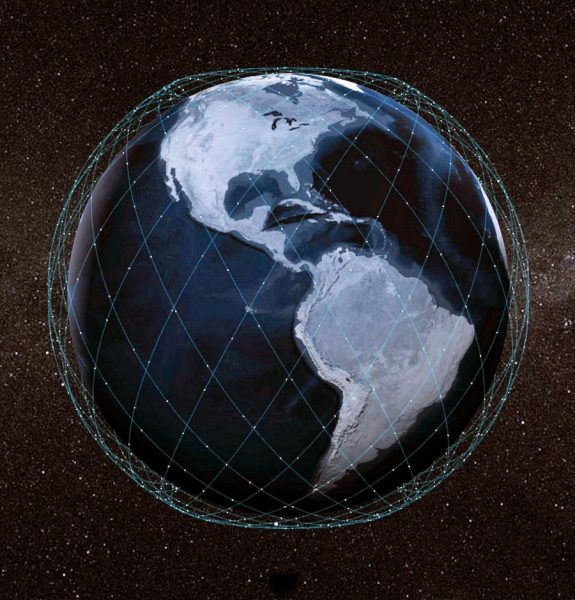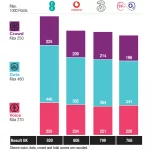Update – OneWeb and SpaceX LEO Ultrafast Broadband Satellites

Good progress is being made by rivals SpaceX and OneWeb, which are both now rapidly moving into a new phase of large-scale deployments on the road to creating two mega constellations of compact Low Earth Orbit (LEO) ultrafast broadband satellites; these should eventually offer “fibre like” speeds to consumers across the world.
At present most broadband internet connectivity services – those delivered to consumers in the UK via satellites at least – come from spacecraft that are positioned high above the Earth in geostationary orbits (GEO / GSO), which often reflects a distance of about 35,000km+ from the planet’s surface.
Such satellites are the size of a double decker bus, have limited peak capacity and take years, as well as hundreds of millions of pounds, to build. As a result latency times are often incredibly slow (around 600 – 1000 milliseconds – useless for fast paced online video games etc.), data allowances are often meagre and service speeds can suffer (especially at peak times).
Advertisement
By comparison both SpaceX (Starlink) and OneWeb (Microsat) hope to eclipse the old solutions by creating vast constellations of significantly smaller LEO satellites. Such platforms tend to weigh around 150-260Kg each and, with solar sails folded, are often smaller than an adult human. The LEOs tend to orbit at around 500-1300km above the Earth, which is significantly nearer than their giant cousins and thus fast latency times of 25-40ms are viable.
Both companies spent the best part of 2019 testing a sizeable number of trial satellites, although over the past couple of months they’ve begun to switch into a mass deployment phase. At the time of writing SpaceX has now launched a total of 240 Starlink satellites (aiming for 4,425 by 2024 and 10,000+ by a later date) and OneWeb have only done 6 but they’ll launch 34 more on 6th February 2020 (aiming for 650 by 2021 and potentially 1,980 by a later date).
SpaceX hopes to have 800 satellites in orbit by around mid-2020, which is enough for their partial global coverage to go commercial by the end of this year or early 2021. Meanwhile OneWeb has said that they aim to begin their first customer demos at the end of 2020 and will then proceed to full commercial global services in 2021.
At this stage we have no idea what sort of packages and prices will be offered to consumers (speeds of up to 1Gbps have been talked about), although we know that OneWeb will initially target the “maritime, aviation, government and enterprise” sectors (remote homes may have to wait a bit longer). One of OneWeb’s early tests also achieved speeds of 400Mbps and average latency of 32ms (here).
Advertisement
We should point out that all of these LEO satellites are designed with a short lifespan and after that they will de-orbit (either automatically or if that fails then gravity will pull them down within 1-5 years). The reason for this is to help tackle fears of too much “space junk” around the Earth (potentially blocking access to space if a chain reaction of collisions were to occur).
Both companies will also have to contend with a growing number of angry astronomers, who fear that the tiny spacecraft will make it increasingly hard to do science through observations. SpaceX has experimented with painting one of their Starlink’s black but most of those being launched remain highly reflective.
We’ve posted this update as an alternative to writing (spamming) about the repetitive launch announcements (e.g. SpaceX), which will become much more frequent during 2020. Sadly these don’t tell us anything terribly new, except that the networks are growing in size. Hopefully the next time we write something up we’ll be able to tell you about some proper tests or live products.
Mark is a professional technology writer, IT consultant and computer engineer from Dorset (England), he also founded ISPreview in 1999 and enjoys analysing the latest telecoms and broadband developments. Find me on X (Twitter), Mastodon, Facebook, BlueSky, Threads.net and Linkedin.
« UK Gov Warns – No More FREE EU Mobile Roaming from 2021, Maybe
ISP TalkTalk Reports UK FTTC Hybrid Fibre Broadband Growth »























































Exciting stuff! At their current rate, i may get access to good speeds before the USO comes into effect.
The USO will come into effect in March, so no. On the other hand Ofcom has allowed up to 12 months for a USO request to be fulfilled so.. possibly. Still that all depends on the questions of when they a) offer services to consumers, and b) make them available in the UK.
Cost is another issue, but we’re expecting it to be beat current satellite packages for value. Time will tell.
Oh, i know. I have been following the news closely. Though, I have little faith in the USO. I’d actually bet my savings that this will come to me before openreach/other providers do. Even with the USO.
@Adam at the rate of build most areas will get cable/Fttp/Gfast long before LEO is even an option.
This is going to ruin FTTP lol, Elon musk is amazing
It won’t ruin existing FTTH in cities but it could be real competition for fixed 4/5G and FTTC.
If this is available when FTTH hasn’t yet reached you then there is little chance FTTH ever will.
I doubt it will touch FTTH, DOCSIS or even 5G (once properly deployed with all the right bands), but it may well threaten FTTC.
We’re still waiting for 4G to be properly deployed on all bands with CA. So SpaceX and OneWeb will be live before large scale 5G deployment.
400mbps? yes with nobody else on
50mbps peak speeds at best.
Each single LEO platform on SpaceX can handle an aggregate download capacity of up to 23Gbps. Given their size and comparison with GSO/GEO broadband satellites, that’s actually pretty huge. I’d say you’re probably looking at closer to 200Mbps+ in the real-world. But that’s SpaceX and sadly I don’t know enough about OneWeb’s rival satellite specs, but I believe they may be less capable.
Don’t get too excited. 23Gbps is only equivalent to the uplinks from a handful of fibre cabinets. Say there are 10 satellites over the UK at any one time: then they could serve around 100K users, at average 2Mbps utilisation each.
This doesn’t appear to be a consumer proposition for replacement of your home FTTC or 4G connection. Rather, I expect it will be a niche product for infill at the very edges of the network – the last 0.5% of users perhaps – or used by enterprise applications, such as fleet vehicles, where 100% geographic coverage is important.
It will be priced at a premium to reflect those advantages over land-based networks, not to attract low-margin, high-traffic consumers.
Totally fair point, of course the way satellites manage capacity tends to be a bit more agressive. Consider that Eutelsat’s KA-SAT satellite, which is a big old GSO / GEO beast at 6.1 tonnes, can handle around 80-90Gbps (offering UK homes speeds of 30-50Mbps) and can accommodate up to 1 million subscribers then you start to see what a massive constellation of LEOs might be able to do. Still, the possibility of peak time congestion may bring performance down, only time will tell how they handle it.
Doesn’t it also depend on the contention ratio?
50:1 consumer ratio would imply ~250k people per satellite?
*Providing a 100Mbps service.
Contention Ratio doesn’t exist, at least not in the form you are alluding to. Never has done really, except as a marketing/sales gimic by BT et al.
If the price is affordable and data limits sufficient, 50Mb would work for me!
I left the UK in Aug 2018, and since then have been living in the Caribbean. Right now i am on an island with only 1 fixed line isp, offering 20-100 Mb fibre in very limited areas, and 10-20Mb DSL in my others. Upon moving into my vastly overpriced apartment last year, the 20Mb DSL could achieve little over 3Mb, and was forced to upgrade to Fibre. The basic 20Mb on a 12 month contract is at current exchange around 100GBP a month, with 100Mb comes in a shade under 300GBP.
In the middle of this year i’ll be moving to an island with a population of little over 11,000 people (country of 400,000), but 20km from the nearest town, and i doubt the local (private) cable company will have laid cable that far. This kind of internet service could cause real disruption in this region, where traditionally everything has been very highly priced.
Well, if you will live in paradise!
Indeed. My heart *bleeds*!!
Try finding out what OneWeb upload speed is? It’s pretty old technology launching satellites that broadcast down to earth, it’s why we’ve had satellite TV for decades, but the Internet isn’t just about being able to broadcast, people will need to upload as well. Upload speeds don’t seem to be mentioned in any press releases or elsewhere for OneWeb, so presumably they are nothing good so they are being deliberately quiet about it.
Cannot wait for this, being from skipton it’s a bit of a catch22, too small of an area that virgin haven’t bothered at all despite cabling towns and cities around us and too much development on FTTC for BT to consider deploying FTTP. 20-40mb doesn’t cut it in 2020. Bring on satellite speeds. Even the real world speeds of around 200-400mb will be massive for us
I expect when you see the monthly cost and slow upload speeds you’ll get with OneWeb that suddenly 20-40Meg will seem perfectly fine. Besides Skipton already has some native FTTP deployment and fairly good speeds for most.
Satellite services like this one are not meant for people already getting 20-40Meg, they are meant for people who are getting nothing or next to nothing with big pockets and desperate enough to pay the price.
You could get a better, faster and more reliable service now for less cost by having a second line put in.
Here in rural North Somerset, our best option at the moment is 4G (appr 50Mbs). This alternative looks promising if it can really deliver 200Mbs and the data allowance is reasonable (200Gb+).
Gigaclear or Truespeed not coming?
Good news for coverage in hard to reach places even though it mean more special debris orbiting the earth quid per quo I suppose
More Space junk cluttering low earth orbit. There’ll be a price to pay.